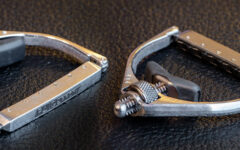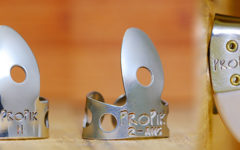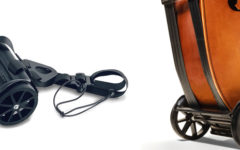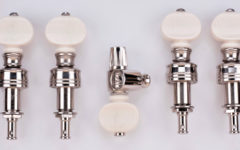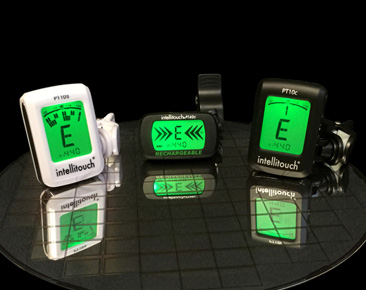
 OnBoard Research has sent us two of their new tuners to check out, and they are marvelous little devices.
OnBoard Research has sent us two of their new tuners to check out, and they are marvelous little devices.
If you’ve been around stringed instruments twenty years or so, you’ll recall the excitement when they introduced the clip-on Intellitouch tuner concept in 1997. These slender, rectangular tuning devices, designed to attach to the headstock of stringed instruments, or the bells of brass ones, became as common on stage and in the studio as extra flatpicks stuck to microphone stands.
The Intellitouch innovation was to include pitch sensing receptors integrated into the clip that held the tuner in place, eliminating the extraneous noise issue when using a microphone-based device. They were fast, accurate, and relatively inexpensive and were quickly embraced by acoustic musicians worldwide. A digital display showed a series of left-and-right arrows that gave a visual representation of the pitch.
Competitors quickly jumped in to the fray, including established manufacturers of tuning devices, and now the market includes everything from cheap, nearly-disposable units that sell for less than $10, to sophisticated, strobe-based tuners that run closer to $50.
For 2016, Intellitouch has incorporated a number of new features and functions that they feel will put them right back on top of the heap. The PT10c, PT10s, and PT40c all boast of the most obvious addition to digital tuners – a clock! In a day when fewer people wear wristwatches than ever, and clocks are less present or obvious in our surroundings, what a perfect thing to have built into your tuner. Musicians at a gig, teachers in a lesson, or anyone timing a practice session would benefit from having an accurate timepiece on their headstock. Now you can check the time in an unobtrusive way as your touch up your tuning.
These new tuners offer three different ways of viewing the display. The PT10c is the least expensive at $19.95, using the more typical needle display to display tuning variation. It is a fully-chromatic tuner, powered by the now standard CR2032 flat battery.
 With the PT10s, the user has the option of using either a needle display, like the 10c, or a new strobe function they call EasyStrobe. With either display, the screen lights up red with the note name to show that you are out of tune, turning to green when you get it just right. The strobe display shows a digital approximation of a spinning strobe wheel, turning to the left when flat and to the right when sharp. Many musicians have preferred the strobe look for years since the wheel spins faster the more out of tune you are, slowing to a static or stopped display when you’re right in there.
With the PT10s, the user has the option of using either a needle display, like the 10c, or a new strobe function they call EasyStrobe. With either display, the screen lights up red with the note name to show that you are out of tune, turning to green when you get it just right. The strobe display shows a digital approximation of a spinning strobe wheel, turning to the left when flat and to the right when sharp. Many musicians have preferred the strobe look for years since the wheel spins faster the more out of tune you are, slowing to a static or stopped display when you’re right in there.
The PT10s sells for $29.95, and also includes a capo setting function where you can select a capo position of 1-5 and the note name display will revert to the open string names. There is also the ability to set an A reference from 410-480, and to choose equal or pure temperament, and is likewise powered by a CR2032 battery. An extra battery is included with the tuner.
 Also selling for $29.95 is the PT40c. It utilizes the traditional Intellitouch arrows display but instead of all the extra features built in to the 10s, this one has a rechargeable battery. A short cable is included with a mini-USB jack on one end and a full-sized USB on the other. I plugged it into my computer and the unit was fully charged in less than 30 minutes. Intellitouch says that a full charge will last for up to 30 days in normal use, and the USB plug should also fit into the majority of phone wall chargers for emergency use.
Also selling for $29.95 is the PT40c. It utilizes the traditional Intellitouch arrows display but instead of all the extra features built in to the 10s, this one has a rechargeable battery. A short cable is included with a mini-USB jack on one end and a full-sized USB on the other. I plugged it into my computer and the unit was fully charged in less than 30 minutes. Intellitouch says that a full charge will last for up to 30 days in normal use, and the USB plug should also fit into the majority of phone wall chargers for emergency use.
The PT40c can adjust the A reference from 430-450 and, like the 10s, can have the tuner calibrated to the keys of C, Bb, Eb, F, G, or A.
Both of these devices are quick and responsive, and very accurate with traditional stringed instruments. They will easily fit the headstocks of any banjo, mandolin, guitar or reso-guitar, and can also accommodate most fiddle headstocks. I’m not sure how well the clamp would fit on a bass headstock, though it should work fine on the bridge or tailpiece.
Also new this year is the Intellitouch GoTune AppClip, for use with smart phones. It’s essentially just a small clip with a cable attached that plugs into your phone’s headphone port to isolate noise and other instruments when using an app for tuning. I haven’t had a chance to test this one out, but there is no reason to think that it wouldn’t be a fine investment of $14.95 for phone tuner users.
All these Intellitouch tuners and clip are available at your favorite music store, or directly from the company online. The addition of the digital clock, low prices, and much smaller size makes these new items a great value when you need a new tuner.

